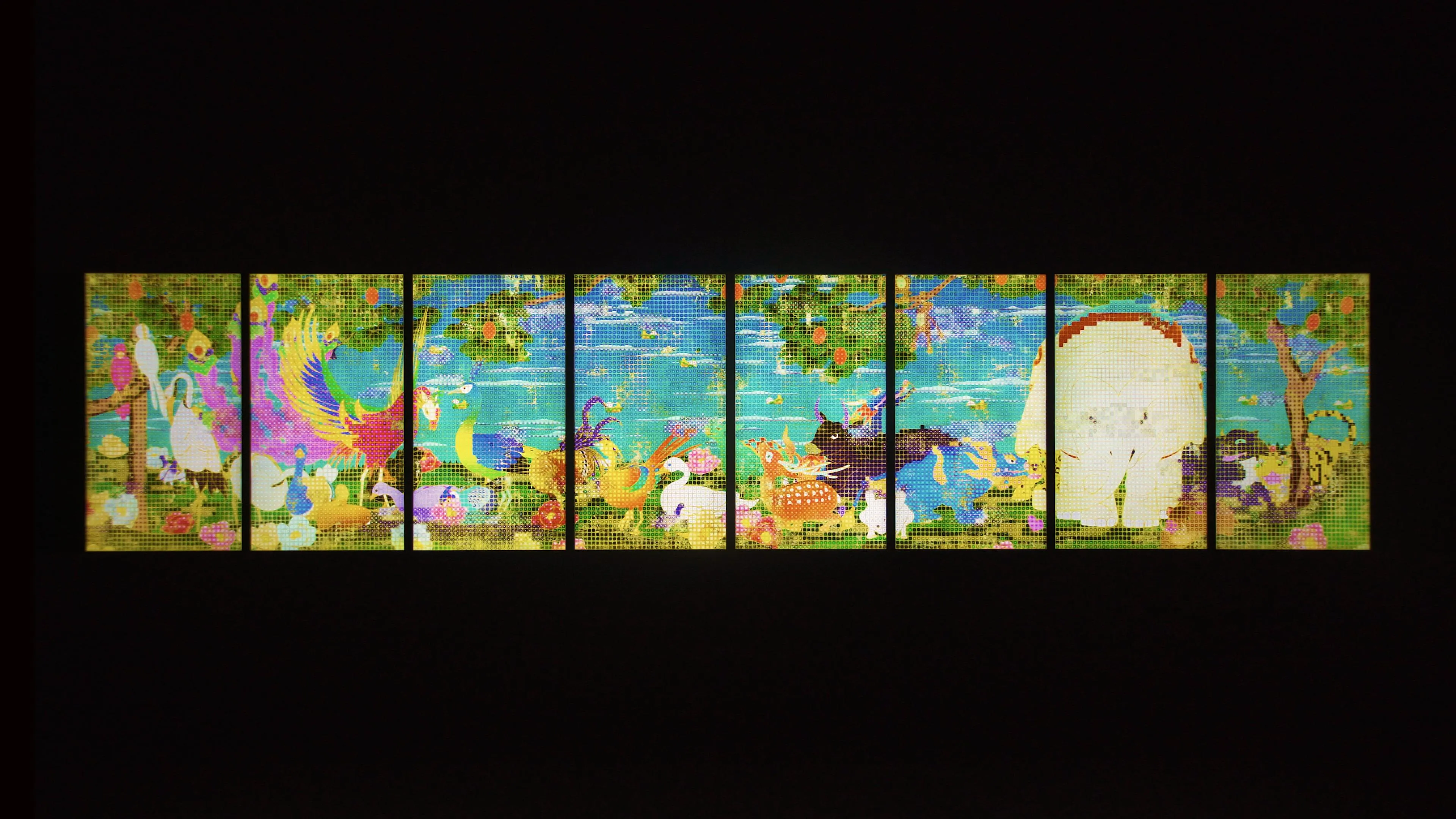高橋コレクション展 アートのなぞなぞ에 소개되었습니다. (Dec, 2017)
ピクセルとマス目。
ピクセルとマス目。
パソコン上でJPEGの画像データの拡大倍率を上げていくと、ディスプレイ上に見えていたイメージが、実は、色の付いた正方形の集合でできていたことに気付く。(Excerpt from the text)







Itō Jakuchū (1716–1800) was an early modern Japanese painter who was active in Kyoto in the mid-Edo period. Jakuchū has left us with a unique style of painting in which the surface is made up of a grid of tens of thousands of squares that are individually colored. This work was inspired by the screen paintings Birds, Animals, and Flowering Plants and Trees, Flowers, Birds and Animals.
Jakuchū’s square paintings remind us of computer-generated pixel art. It has been proposed that Jakuchū’s squares pictures were inspired by industrial production constraints in the designs of Nishijin (traditional high-quality silk fabric that is woven in Nishijin, Kyoto). Pixel art was also born from functional limitations. Those functional limitations no longer exist but pixel art is still a very popular form of expression. This is perhaps why we feel an intuitive digital sense to Jakuchū's square works. The colors of Jakuchū’s work are the result of the optical phenomena of visual mixing of color combinations within the squares. It appears as if Jakuchū understood optical mixing of colors at a time before Impressionism and Pointillism.
This artwork was created in a virtual 3-D space in which 3-D animals move. The space was then converted into what teamLab calls ultrasubjective space. Then, the color in the 3-D space is split by the color pattern of the squares. For example, if the pattern of a square is colored in red and blue, that part corresponds to purple in the three dimensional space.
The squares of the screen are fixed while the space continues to move, and thus the color inside the squares is on a different time axis to the space. Seen as a whole from a distance, brilliantly shining colors occur, and the world of plants and animals in the space will move at a slow time axis. When viewed up close, the colors divided by the finely drawn patterns of each square will change on a rapid time axis. Two time axes co-exist in this work.
In addition, parts of the image squares are filled in with the most frequent color in the squares, forming an abstract world. Furthermore, when a visitor stands in front of the work, the squares near them are similarly painted. The plants and animals move in space, but are abstracted by the fixed squares on-screen, creating a new visual expression through pixel art.

종료
2024.11.02(Sat) - 12.22(Sun)
Hiroshima Museum of Art, Hiroshima
Group Exhibition

종료
2024.8.24(Sat) - 10.20(Sun)
Saga Prefectural Art Museum, Saga
Group Exhibition

종료
2022.2.22(Tue) - 8.29(Mon)
Kunsthalle Praha, Prague
Group Exhibition
高橋コレクション展 アートのなぞなぞ에 소개되었습니다. (Dec, 2017)
ピクセルとマス目。
パソコン上でJPEGの画像データの拡大倍率を上げていくと、ディスプレイ上に見えていたイメージが、実は、色の付いた正方形の集合でできていたことに気付く。(Excerpt from the text)
RETRIP에 소개되었습니다. (2016年11月3日)
チームラボの展示も!高知で「高橋コレクションマインドフルネス!2016」開催
高知県立美術館(高知県)にて「高橋コレクション マインドフルネス!2016」が開催されます。チームラボの「世界は、統合されつつ、分割もされ、繰り返しつつ、いつも違う」を展示するんだとか。期間は2016年11月3日(木・祝) ~ 2017年1月22日(日)までです。
(Excerpt from the text)
PUBLIC RELATIONS OFFICE, HIGHLIGHTING Japan에 소개되었습니다. (Jun , 2016)
INTARACTIVE digital artworks produced by japan's teamLab have been capturing the imagination of people of all ages around the world.(Excerpt from the text)